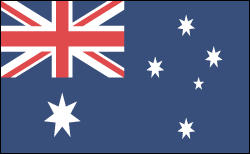
Geography
The continent of Australia, with the island state of Tasmania, is approximately equal in area to the United States (excluding Alaska and Hawaii). Mountain ranges run from north to south along the east coast, reaching their highest point in Mount Kosciusko (7,308 ft; 2,228 m). The western half of the continent is occupied by a desert plateau that rises into barren, rolling hills near the west coast. The Great Barrier Reef, extending about 1,245 mi (2,000 km), lies along the northeast coast. The island of Tasmania (26,178 sq mi; 67,800 sq km) is off the southeast coast.
Government
Democracy. Symbolic executive power is vested in the British monarch, who is represented throughout Australia by the governor-general.
History
The first inhabitants of Australia were the Aborigines, who migrated there at least 40,000 years ago from Southeast Asia. There may have been between a half million to a full million Aborigines at the time of European settlement; today about 350,000 live in Australia.
Dutch, Portuguese, and Spanish ships sighted Australia in the 17th century; the Dutch landed at the Gulf of Carpentaria in 1606. In 1616 the territory became known as New Holland. The British arrived in 1688, but it was not until Captain James Cook's voyage in 1770 that Great Britain claimed possession of the vast island, calling it New South Wales. A British penal colony was set up at Port Jackson (what is now Sydney) in 1788, and about 161,000 transported English convicts were settled there until the system was suspended in 1839.
Free settlers and former prisoners established six colonies: New South Wales (1786), Tasmania (then Van Diemen's Land) (1825), Western Australia (1829), South Australia (1834), Victoria (1851), and Queensland (1859). Various gold rushes attracted settlers, as did the mining of other minerals. Sheep farming and grain soon grew into important economic enterprises. The six colonies became states and in 1901 federated into the Commonwealth of Australia with a constitution that incorporated British parliamentary and U.S. federal traditions. Australia became known for its liberal legislation: free compulsory education, protected trade unionism with industrial conciliation and arbitration, the secret ballot, women's suffrage, maternity allowances, and sickness and old-age pensions.
Australia fought alongside Britain in World War I, notably with the Australia and New Zealand Army Corps (ANZAC) in the Dardanelles campaign (1915). Participation in World War II brought Australia closer to the United States. Parliamentary power in the second half of the 20th century shifted between three political parties: the Australian Labour Party, the Liberal Party, and the National Party. Australia relaxed its discriminatory immigration laws in the 1960s and 1970s, which favored Northern Europeans. Thereafter, about 40% of its immigrants came from Asia, diversifying a population that was predominantly of English and Irish heritage. An Aboriginal movement grew in the 1960s that gained full citizenship and improved education for the country's poorest socioeconomic group.
In March 1996 the opposition Liberal Party–National Party coalition easily won the national elections, removing the Labour Party after 13 years in power. Pressure from the new, conservative One Nation Party threatened to reduce the gains made by Aborigines and to limit immigration.
In Sept. 1999, Australia led the international peacekeeping force sent to restore order in East Timor after pro-Indonesian militias began massacring civilians to thwart East Timor's referendum on independence.
In Nov. 1999, Australia's 11.6 million voters rejected a referendum that would have ended Australia's formal allegiance to the British Crown. In 2000, Prime Minister Howard instituted a new tax system, lowering income and corporate taxes, and adding sales taxes on goods and services.
John Howard won a third term in Nov. 2001, primarily as the result of his tough policy against illegal immigration. This policy has also brought him considerable criticism: refugees attempting to enter Australia—most of them from Afghanistan, Iran, and Iraq and numbering about 5,000 annually—have been imprisoned in bleak detention camps and subjected to a lengthy immigration process. Asylum-seekers have staged riots and hunger strikes. Howard has also dealt with refugees through the “Pacific solution,” which reroutes boat people from Australian shores to camps in Papua New Guinea and Nauru. In 2004, however, the government began easing its policies on immigration.
Prime Minister Howard sent 2,000 Australian troops to fight alongside American and British troops in the 2003 Iraq war, despite strong opposition among Australians.
In July 2003, Australia successfully restored order to the Solomon Islands, which had descended into lawlessness during a brutal civil war.
Australia has been the victim of two significant terrorist attacks in recent years: the 2002 Bali, Indonesia, bombings by a group with ties to al-Qaeda in which 202 died, many of whom were Australian, and the 2004 attack on the Australian embassy in Indonesia, which killed ten.
In Oct. 2004, Howard won a fourth term as prime minister. When rival security forces in East Timor began fighting each other in 2006, Australia sent 3,000 peacekeeping troops to stem the violence. Howard was defeated by the Labor Party's Kevin Rudd in elections in November 2007. Rudd campaigned on a platform for change, and promised to focus on the environment, education, and healthcare. Observers predicted Rudd would maintain a close relationship with the United States.
Hiç yorum yok:
Yorum Gönder